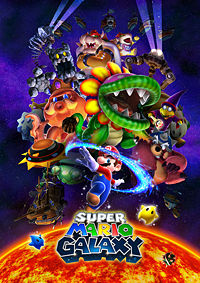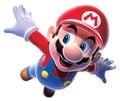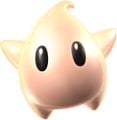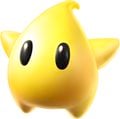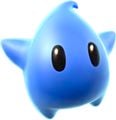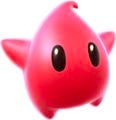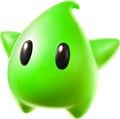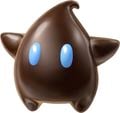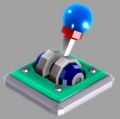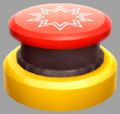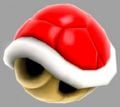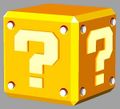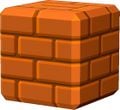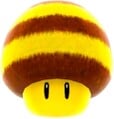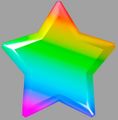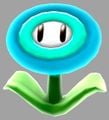Super Mario Galaxy: Difference between revisions
m (The full Korean title is "Super Mario Wii: Galaxy Adventure" (슈퍼 마리오 Wii 갤럭시 어드벤처)) |
Unknownchar (talk | contribs) |
||
| Line 125: | Line 125: | ||
*[[Grand Finale Galaxy]] (240 stars. 120 stars with both Mario & Luigi) | *[[Grand Finale Galaxy]] (240 stars. 120 stars with both Mario & Luigi) | ||
{{endspoiler}} | {{endspoiler}} | ||
===Beta Levels=== | |||
*[[Star World]] | |||
==Prankster Comets== | ==Prankster Comets== | ||
Revision as of 11:57, September 20, 2008
Super Mario Galaxy (Super Mario Wii: Galaxy Adventure in South Korea) is the latest sequel to the series of Mario's 3-D platformers, after Super Mario 64 and Super Mario Sunshine. It uses parts of the tech demo for the GameCube, Super Mario 128. It had 700,000 copies preordered in Japan, and 400,000 in the U.S. Template:Fact
Super Mario Galaxy, unlike other Mario games, takes place in deep space. Most of the game's levels consist of many small planets and planetoids, as well as bigger planets. The game has 120 stars to collect, though an additional quest can be unlocked.
Story
Every hundred years a comet passes over the Mushroom Kingdom and rains down magical stars and stardust. Princess Peach invites Mario to her castle to join in the festivities and receive a special gift. As the citizens of the kingdom are celebrating the centennial event, Bowser attacks the Toads with his airships and freezes them in crystals. He "invites" Peach to the creation of his new galaxy and warps into space with her castle to the center of the universe. When Mario tries to save her, a Magikoopa breaks the airborne path to the castle causing Mario to fall onto an unknown land. Template:Spoiler
Mario later wakes up on a small grassy moon and meets three Space Rabbits who promise to tell Mario where he is if he catches them. When he does so, they take him to meet Princess Rosalina, who tells Mario that the universe is in great peril after Bowser attacked her "ship", the Comet Observatory, and stole the Power Stars, including the seven Grand Stars. Without these, the Comet Observatory is doomed. Rosalina asks him to rescue the Grand Stars in order to defeat Bowser, who took Peach to the center of the universe. Mario then starts his journey across the galaxies, freeing Power- and Grand Stars. Once five of the Grand Stars are collected, the Comet Observatory becomes a starship and takes Mario to the center of the universe.
Here he defeats Bowser in his brand-new galaxy, retrieves the last Grand Star, and rescues Princess Peach. Without this Grand Star, the sun of Bowser's near-complete galaxy undergoes a supernova and becomes a gigantic black hole. Everything in the universe begins to fall in. The Lumas from the Comet Observatory, including the Luma who had faithfully accompanied Mario, throw themselves into the black hole, in order to neutralize it. The Lumas attack the black hole's singularity, and then it soon disintegrates in a massive explosion. Mario appears in front of Rosalina, who had somehow managed to save him from the cataclysm. She tells him that this is not the end, but a new beginning for the universe, and that the universe is an endless cycle, but one that never repeats itself exactly the same way each time.
Mario later awakens in the Mushroom Kingdom near Peach's castle. He sees everyone he's met throughout his adventure celebrating, while Bowser and Peach sit next to him. When he looks in the air, he notices a green light of a new galaxy. "Welcome! Welcome new galaxy!" Mario exclaims, as the camera zooms out into space, revealing that the whole universe has been merged into one giant galaxy, but the galaxy Mario saw in the sky is not shown. If the player continues with the file, Rosalina will say if you collect all 120 Power Stars, the player can travel the new world. If the player has finished the game with 120 stars, after the credits Rosalina and a group of Lumas appear on the planet Mario started on at the beginning of the game. Rosalina says "I'll be watching you from the stars," and flies off to the Comet Observatory. Then the white Luma is shown to be alive, now residing on the small planet. If the player has beaten the game with 120 stars with Mario, a Luigi tab will appear with him saying "Super Luigi Galaxy!".
The Luigi Story goes exactly the same as Mario's. Even the Luigi in Mario's story is still Luigi. When the player has defeated Bowser and continue with the Luigi story, Rosalina will again say if Luigi collects all 120 stars, the player can travel to a new world. When the player collected 120, the player can travel to Grand Finale Galaxy, the new world and the same new galaxy Mario saw in the ending movie. This galaxy is parallel to the Mushroom World. The last 121st star can be found here. Template:Endspoiler
Gameplay
Super Mario Galaxy has several innovations and additions to the basic Mario 3D game concept, which it takes over from Super Mario 64 rather than Super Mario Sunshine. Mario is controlled with the control stick of the Nunchuck and can jump with the A button on the Wii Remote. The Z button works just as the Z trigger did in Super Mario 64. The player uses it to make Mario crouch, do somersaults and do Long Jumps. The C button centers the camera behind Mario, the D-Pad of the Wii Remote allows it adjust the camera angle manually. The game also uses the motion-sensors of the Wii Remote. The pointer of the Remote appears as the Star Cursor on the screen. The Star Cursor is used to perform a variety of actions, such as using Pull Stars, manipulating Sling Pods, and collecting Star Bits. The player can shake the Wii Remote and make Mario perform a Star Spin.
When the player presses B, a Star Bit is fired from the camera's position to the place the Star Cursor is pointing at. When enemies are hit by a Star Bit, they are made dizzy and Mario can kick them by approaching them, thus defeating them and making them release Star Bits. Mario can also defeat all enemies traditionally by jumping on them, releasing a coin which heals him. Using the Star Spin to defeat enemies is also possible. The player can use any of these tactics or only one of them during the entire game, as a specific tactic is never required to defeat a regular enemy. Only special enemies such as the Giant Goomba in the Gateway Galaxy might require a Star Spin. Several enemies are, however, much easier to defeat by shooting them than by jumping on them. As in Super Mario Sunshine, Mario can jump on NPCs to gain extra height or annoy them.
A "Co-Star" (Co-op) mode is available, in which the second player controls a second Star Cursor. The extra Star Cursor, unlike the main one, has the power to hold enemies still by pointing at them and holding A, shake bushes by moving the pointer across them, and push certain things around. It can also collect Star Bits and fire them. When the second Star Cursor is pointed at Mario and A is pressed, the second player can make Mario jump. Combining both jump techniques can make Mario jump higher than when only controlled with one controller.
Mario's life meter has been decreased to 3 total. There is no longer a separate health bar for underwater levels which decreases slowly. Instead, Mario has an air meter which decreases and hurts Mario's health when it hits 0. The Life Mushroom replenishes any lost health and adds a second health meter, making Mario's max health six. When Mario's health drops down to 3 again, the effect of the Life Mushroom is lost.
Mario explores a 3D world with planets which have their own gravity. Several levels have arrows which Mario can turn around with a Star Spin, changing the direction of the gravity. The Launch Star allows Mario to launch off of a planet and go flying to the next. There is little or no warning that a boss might be located on the next planet, little indication that Mario may be facing something terrible or something peaceful on where he's headed next, and no loading times and screens. The game also contains side-scrolling levels reminiscent of New Super Mario Bros. with classic enemies such as Thwomps and Piranha Plants. These side-scrolling levels may also contain gravity, allowing Mario to walk on the ceiling.
Levels
Power Stars make a comeback. The goal of the game is to collect 60 stars and defeat Bowser. Similar to Princess Peach's Castle in Super Mario 64, the Comet Observatory acts as the game's hub world. There, Mario can access the galaxies from domes such as the Terrance. New areas in the Comet Observatory become accessible as Mario gains Power Stars and Grand Stars. A minimum number of Power Stars is required to have enough power to go to each multi-star galaxy, single non-Grand Star galaxies with a ? Block icon when locked are bonuses for finishing certain star missions. The game has a level intro for each star, as in Super Mario Sunshine.
In several levels, Mario encounters Luigi, who helps him getting a secret star that Mario could not get alone. Mario receives a letter from Luigi every time Luigi has found a Power Star, including a picture which helps Mario find Luigi. After the main game is finished, Mario can return and collect up to 120 stars. Super Mario Galaxy contains a few different types of stars, including red, green, and comet stars. The Green Power Stars are secret stars which are used to unlock the Trial Galaxies and one Red Power Star appears when Mario returns to the gate, which allows usage of the Red Star in the Observatory.
After finishing a level, Mario's highest score of coins for the galaxy is recorded and the collected Star Pieces are transferred to the Comet Observatory, where Mario can later use them to feed Hungry Lumas.
The Gate
The Terrace
- Good Egg Galaxy (1 star)
- Honeyhive Galaxy (3 stars)
- Loopdeeloop Galaxy
- Flipswitch Galaxy
- Bowser Jr.'s Robot Reactor (8 stars)
The Fountain
- Space Junk Galaxy (9 stars)
- Battlerock Galaxy (12 stars)
- Rolling Green Galaxy
- Hurry-Scurry Galaxy
- Bowser's Star Reactor (15 stars)
The Kitchen
- Beach Bowl Galaxy (16 stars)
- Ghostly Galaxy (20 stars)
- Bubble Breeze Galaxy
- Buoy Base Galaxy
- Bowser Jr.'s Airship Armada (23 stars)
The Bedroom
- Gusty Garden Galaxy (24 stars)
- Freezeflame Galaxy (26 stars)
- Dusty Dune Galaxy (29 stars)
- Honeyclimb Galaxy
- Bowser's Dark Matter Plant (33 stars)
The Engine Room
- Gold Leaf Galaxy (34 stars)
- Sea Slide Galaxy (36 stars)
- Toy Time Galaxy (40 stars)
- Bonefin Galaxy
- Bowser Jr.'s Lava Reactor (45 stars)
The Garden
- Deep Dark Galaxy (46 stars)
- Dreadnought Galaxy (48 stars)
- Melty Molten Galaxy (52 stars)
- Matter Splatter Galaxy
Hungry Luma Galaxies
At certain intervals, Hungry Lumas will appear outside of each dome in the Observatory, asking for a high quantity of star bits (Mario or Luigi will be able to use their total stash from all completed star missions, however). They will transform into whole galaxies when fully fed, each with one Power Star.
- Sweet Sweet Galaxy (outside of the Terrace, 7 stars, 400 star bits)
- Sling Pod Galaxy (outside of the Fountain, 15 stars, 400 star bits)
- Drip Drop Galaxy (outside of the Kitchen, 22 stars, 600 star bits)
- Bigmouth Galaxy (outside of the Bedroom, 39 stars, 800 star bits)
- Sand Spiral Galaxy (outside of the Engine Room, 50 stars, 1000 star bits)
- Boo's Boneyard Galaxy (outside of the Gate, 58 stars, 1200 star bits)
- Snow Cap Galaxy (outside of the Garden, 65 stars, 1600 star bits)
The Center of the Universe
- Bowser's Galaxy Reactor (60 stars and the Engine Room)
The Trial Galaxies
The trial galaxies are slightly more difficult than the other galaxies, and require all 3 Green Power Stars to open up.
The Grand Finale
- Grand Finale Galaxy (240 stars. 120 stars with both Mario & Luigi)
Beta Levels
Prankster Comets
- Main article: Prankster Comet
Prankster Comets are objects which interfere with a Galaxy, giving it an extra attribute. The thirty comet stars are obtained by completing special challenges in the larger galaxies, such as speed runs of certain missions, "daredevil" runs (in which Mario's max health is one), racing cosmic clones of Mario or Luigi, and double the speed of enemies. Any one of these (and only one per galaxy) appear at random times in each of the fifteen multi-star galaxies. The other fifteen are a fifth comet, common to each galaxy that appears after defeating Bowser for the first time, forcing missions where the player must collect one hundred Purple Coins.
Forms
Mario regains his ability to gain different abilities via special mushrooms, similar to Super Mario 64, in which he could obtain the Wing-, Vanish-, and Metal Caps. The Cannon from Super Mario 64 also returns. Mario transforms in the these forms with the stated items:
| File:BeeMario.jpg | File:BooMario.jpg | File:Ice Mario.jpg | 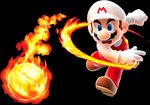
|
| Bee Mario, with the Bee Mushroom |
Boo Mario, with the Boo Mushroom |
Ice Mario, with the Ice Flower |
Fire Mario, with the Fire Flower |
| File:Springmario.jpg | File:SMG RainbowMario.jpg | File:Flying Mario Artwork.jpg | |
| Spring Mario, with the Spring Mushroom |
Rainbow Mario, with the Rainbow Star |
Flying Mario, with the Red Star |
Characters
Mario encounters many new and old characters in his adventure through the galaxies. Many of these are met in one or more galaxies, but others, such as Rosalina, are found on the Comet Observatory.
Enemies
The game has old enemies such as Goombas from Super Mario Bros. and round Goombas from Super Mario World, enemies which make their 3D debut such as Magikoopas and Dry Bones, as well as new enemies, which include the Electrogoombas and Mandibugs.
New Enemies
Returning Enemies
Bosses
Sixteen bosses are in the game. Some of them are fought more than once. These numbers count comet battles as separate.
- Dino Piranha x1
- King Kaliente x2
- Bugaboom x1
- Megaleg x1
- Kamella x2
- Tarantox x1
- Topmaniac x2
- Bouldergeist x1
- Major Burrows x1
- Baron Brr x1
- Undergrunt Gunner x3
- Mecha Bowser x1
- Kingfin x1
- Fiery Dino Piranha x1
- Bowser Jr. x1
- Bowser x3
Items
In Mario's new adventure, he uses many new and returning items that give him moves he's never had before.
Mini-Games
All except Bob-Omb Blasting can be found in the trial galaxies.
Unlockable Secrets
Once the player beats the game and gains 120 stars as Mario, he or she can go back to Rosalina and ask to fight Bowser again. Once Bowser is re-defeated, the Player now has the option to play as Luigi. He is faster and jumps higher than Mario, but he has less friction, making the game slightly harder. Luigi's Star Spin also takes slightly longer to re-charge, and he has less air capacity than his brother. Luigi also loses air for every time he uses the Star Spin underwater. Once the player beats the game and collects 120 stars as Luigi, the 121st star becomes available.
When playing through the game as Luigi, the stars that required Mario to meet Luigi still feature a non-playable Luigi, bringing up the issue of two Luigis in the game. When the playable Luigi first saves the non-playable one from the Ghostly Galaxy, Luigi dismisses his rescuer merely as someone in the universe who happens to look like him. When Luigi rescues himself afterwards, the lost Luigi refers to him as "me" (for example, "I knew I could rely on... me!"). Rosalina dismisses the two as twins. At first, they appear to be exactly the same. However, if one looks closely at them, one will notice the playable Luigi is wearing lighter green clothes and is slightly shorter. It is unknown which one is the true Luigi.
If the player collects 9999 Star Bits along with 120 stars, all the coconuts in the game turn into watermelons, though 6000 star bits must be fed to the Hungry Lumas to get 7 of those stars. Template:Endspoiler
Reception and Sequel
Famitsu Magazine has given Super Mario Galaxy a score of 38/40. (This means two reviewers gave it a nine, and two gave it a perfect ten.) To put that in perspective, Super Mario Sunshine was given 37/40 and Super Mario 64 39/40. The Official Nintendo Magazine UK gave the game 97%. It was called the best game of the decade and praised for having excellent graphics, sound and gameplay as well as a mixture of new features and classic features.
Shigeru Miyamoto, after E3 2008, said that a new game in the Super Mario 3D series will come out on the Wii. It has been confirmed that the Super Mario Galaxy team is working on a new project, which will not release before autumn 2009. There have been hints that many forms of Mario which did not make the cut for Super Mario Galaxy might appear in the sequel. It would the first time that there are 2 Super Mario 3D games on the same console.Template:Fact
Voice Cast
- Charles Martinet as Mario, Luigi, Cosmic Mario
- Kenny James (Kenneth W. James) as Bowser
- Samantha Kelly as Princess Peach, Toad Brigade
- Mercedes Rose as Rosalina
- Caety Sagoian as Bowser Jr.
Media
Artwork
<showhide>
<show>
- Galaxy MarioArtwork 00003.jpg
Mario Star Spinning - Tykemario.jpg
Mario and a Luma - PeachMP8a.PNG
- BowserSMG.jpg
- SMG BowserJr.jpg
- PrincessRosetta.jpg
- SMG Toad.jpg
- SMG Magikoopa.jpg
- QueenBee.jpg
- Mantastar.jpg
- Rollstar.jpg
- Steponblock.jpg
- Questioningcoin.jpg
- SMG SpringMushroom.jpg
- SMG BooSuit.jpg
- Beeluigi.png
Bee Luigi
</show></showhide>
Box Art
Audio
Trivia
- Bowser uprooted Peach's castle once before, in Paper Mario, but only lifted it into the sky, and it is unknown if it was in space in that game, or if it was simply dark outside.
- Like the beginning of Super Mario 64, Paper Mario and Paper Mario: The Thousand-Year Door, this game's opening features a letter from Peach to Mario.
- Surfing 101 and The Galaxy's Greatest Wave have the same functions as Super Mario Sunshine's Ricco Harbor minigame Blooper Safari, with the Manta Ray replacing the Bloopers.
- People who pre-ordered Galaxy in the US got a small booklet and a commemorative coin with Mario soaring and a Luma on it.
- By coincidence, the title Super Mario Galaxy was first mentioned in a fan letter written to Nintendo Power by Jimmy Peterford of Glen Cove, New York. The letter in question, which was printed in the December 1991 issue, detailed a fantasy game system called the Raw Power System, which would come bundled with a game titled Super Mario Galaxy, but in Jimmy's words, would be "better known as Super Mario Bros. 24!"
- In Mario Kart Wii, the Rainbow Road stage is somewhat based around Super Mario Galaxy - Star Bits can be seen hovering from above, a star launcher will send players across the sky, Launch Stars can be seen on the railing, and the entire stage is featured in space. The music is a remix from Super Mario Galaxy as well.
- During a cutscene after completing the game Rosalina says, "When stars die, they turn to stardust and scatter across the cosmos. Eventually, that stardust reforms to create a new star...And so the cycle of life continues. But the cycle never repeats itself in quite the same way...". This bit of information is true about stars in real life.
- Yoshi makes a cameo appearance as a planet. He can also be selected as the player's icon for a savegame.
- The game has a few cameo appearances from different series, including a space ship wandering Space Junk Galaxy and Ghostly Galaxy that looks very similar to Captain Olimar's ship from the Pikmin games. Another is in Buoy Base Galaxy, where the planet floating above the main planet is shaped like a giant Poké Ball from the Pokémon series.
External Links
- Official Japanese Site
- Official English Site
- Prologue Video (IGN)
- Super Mario Galaxy Reviews, Guide, Videos, Screenshots and more! (IGN)
